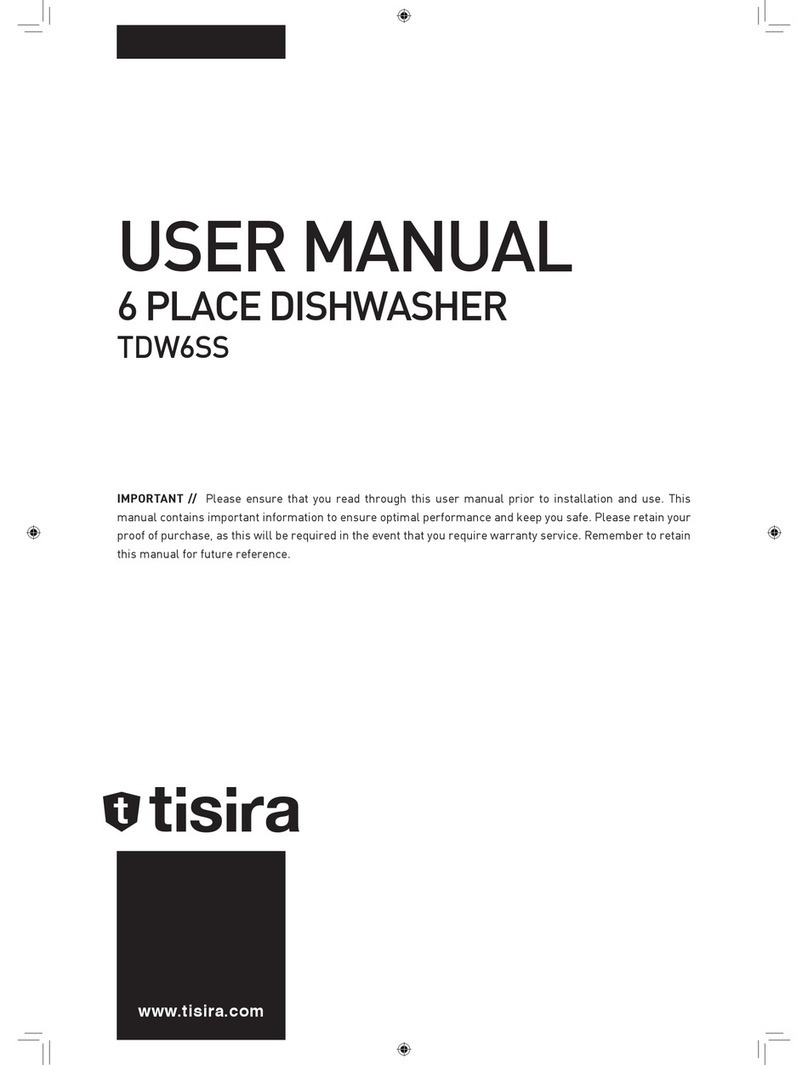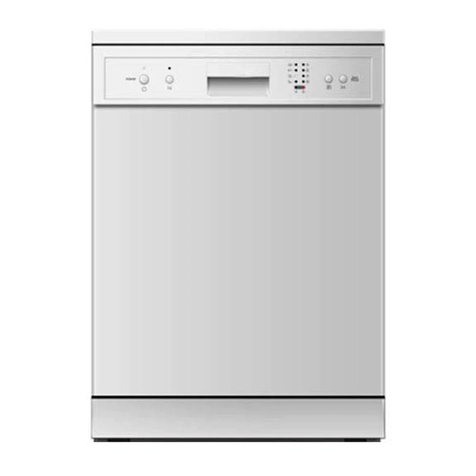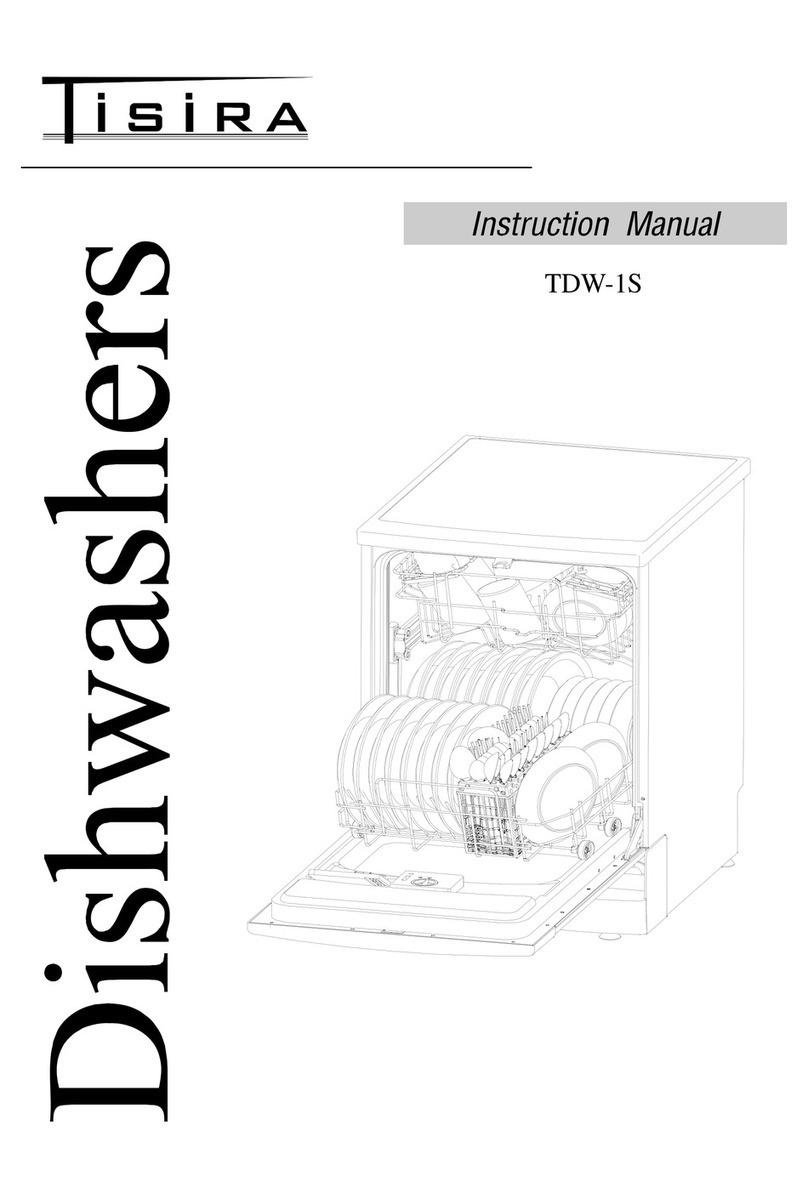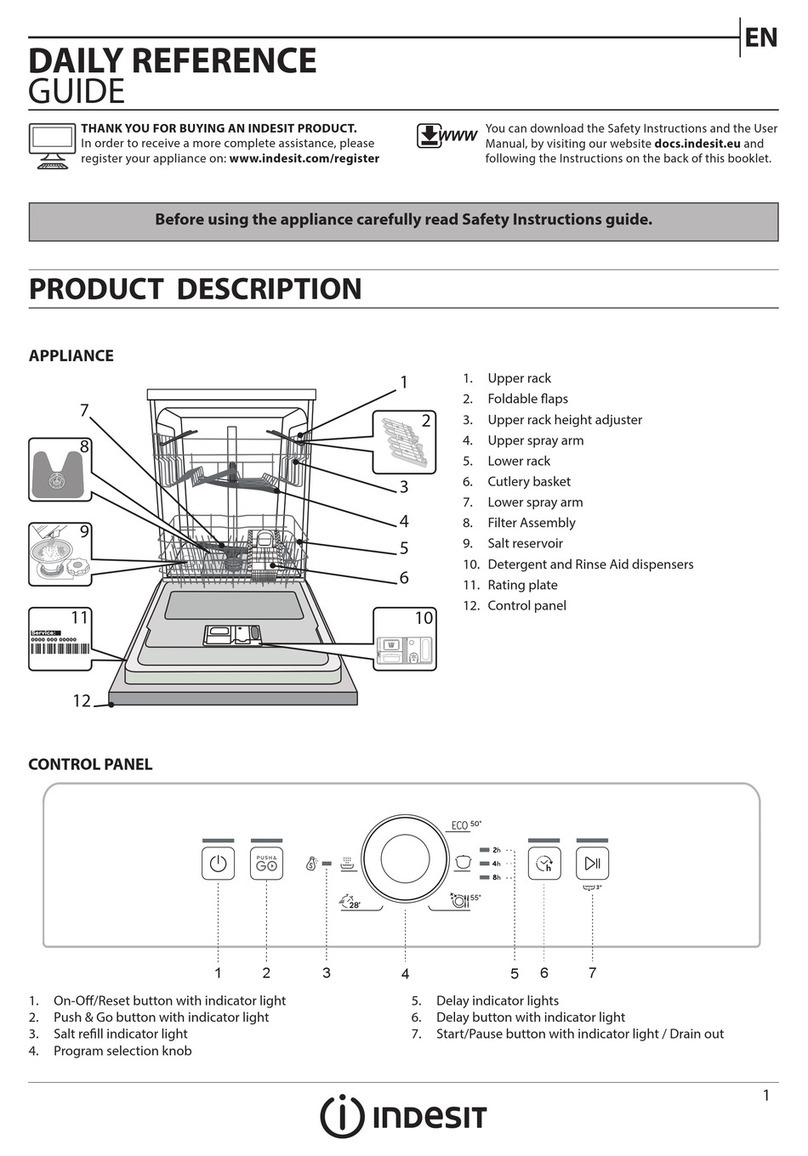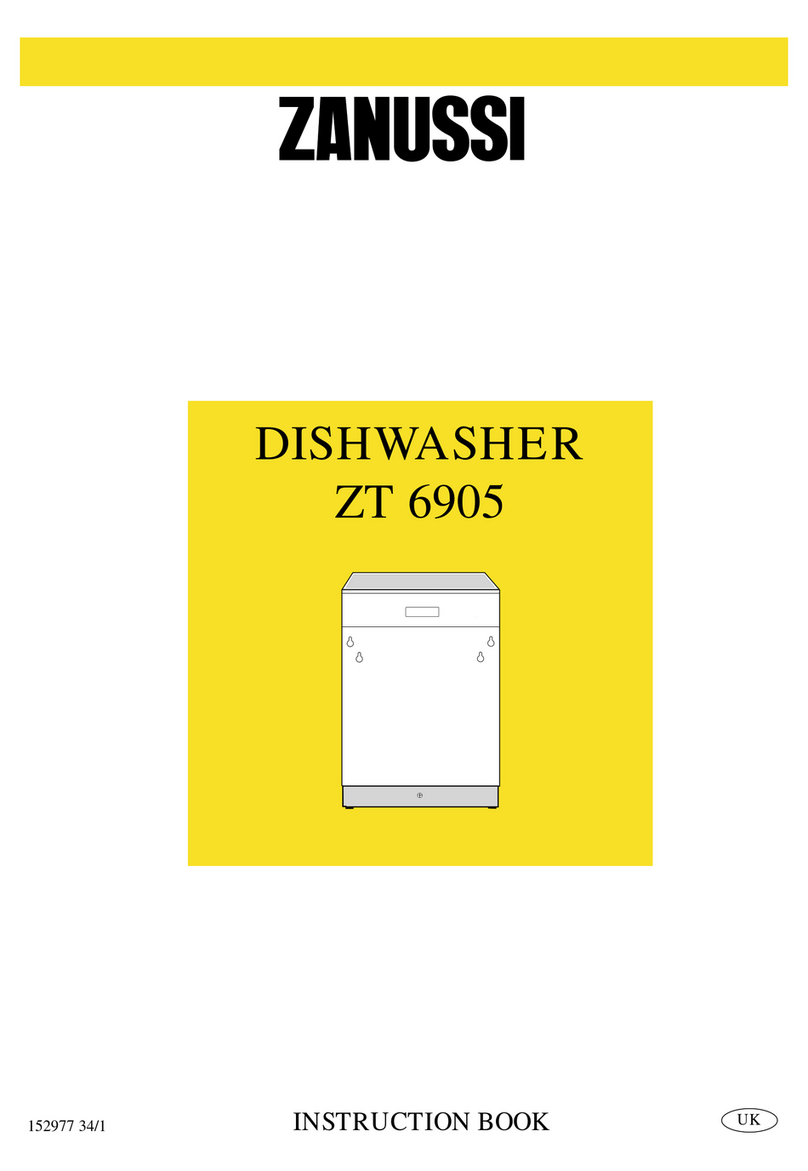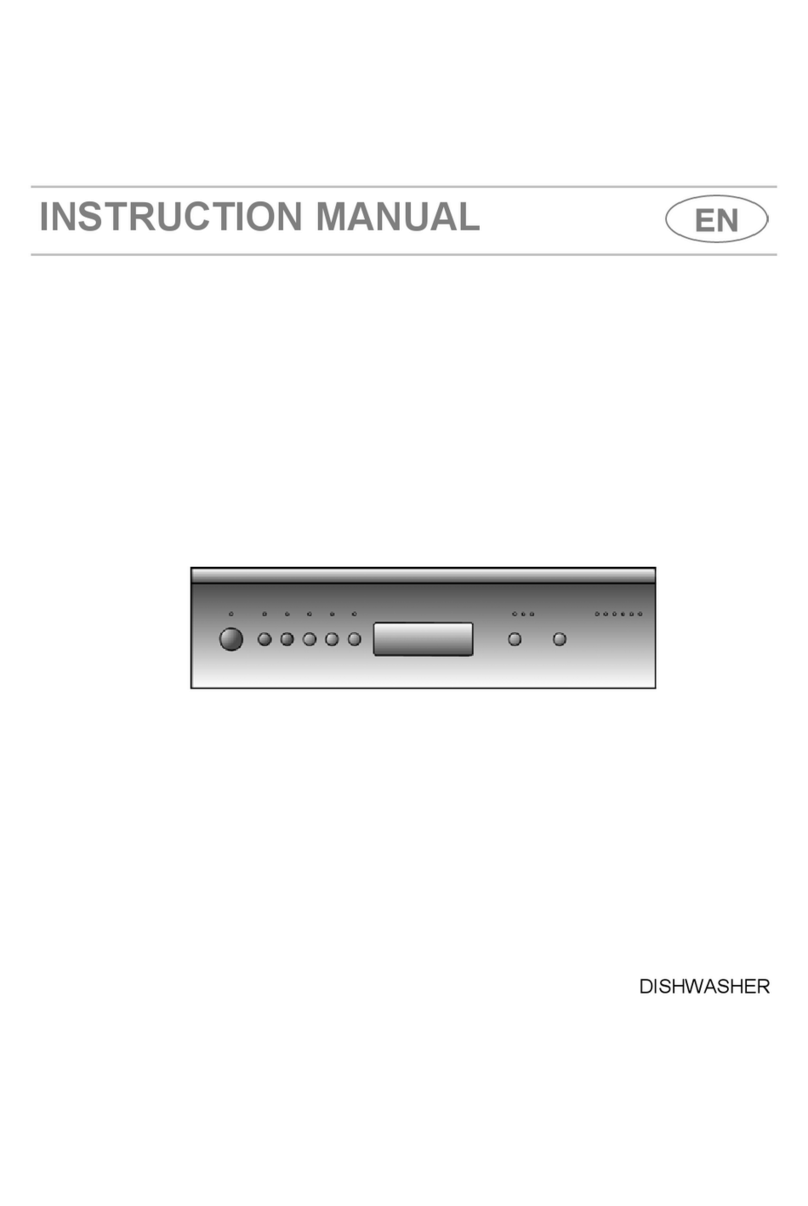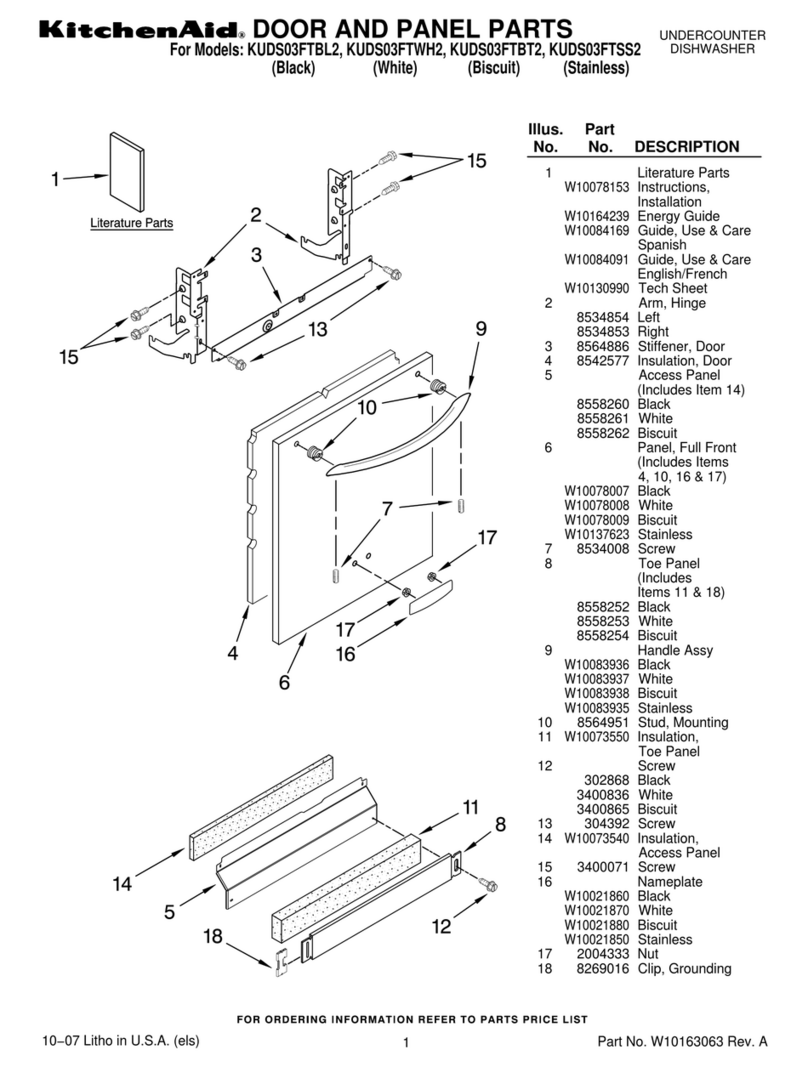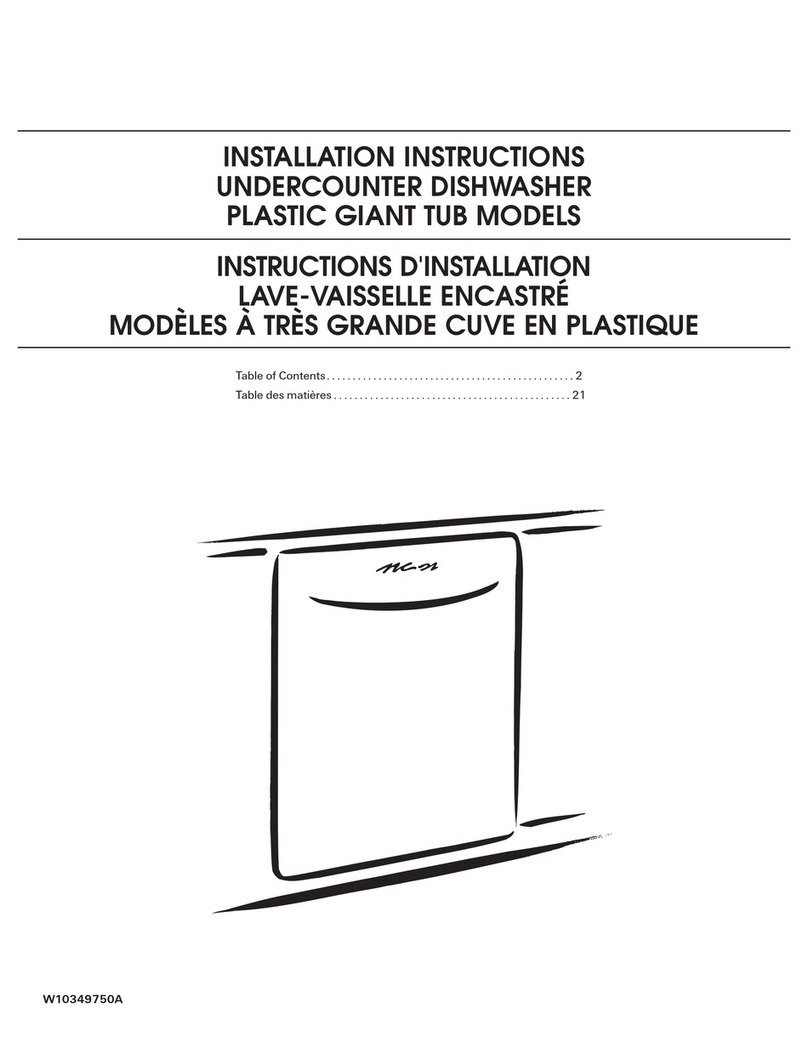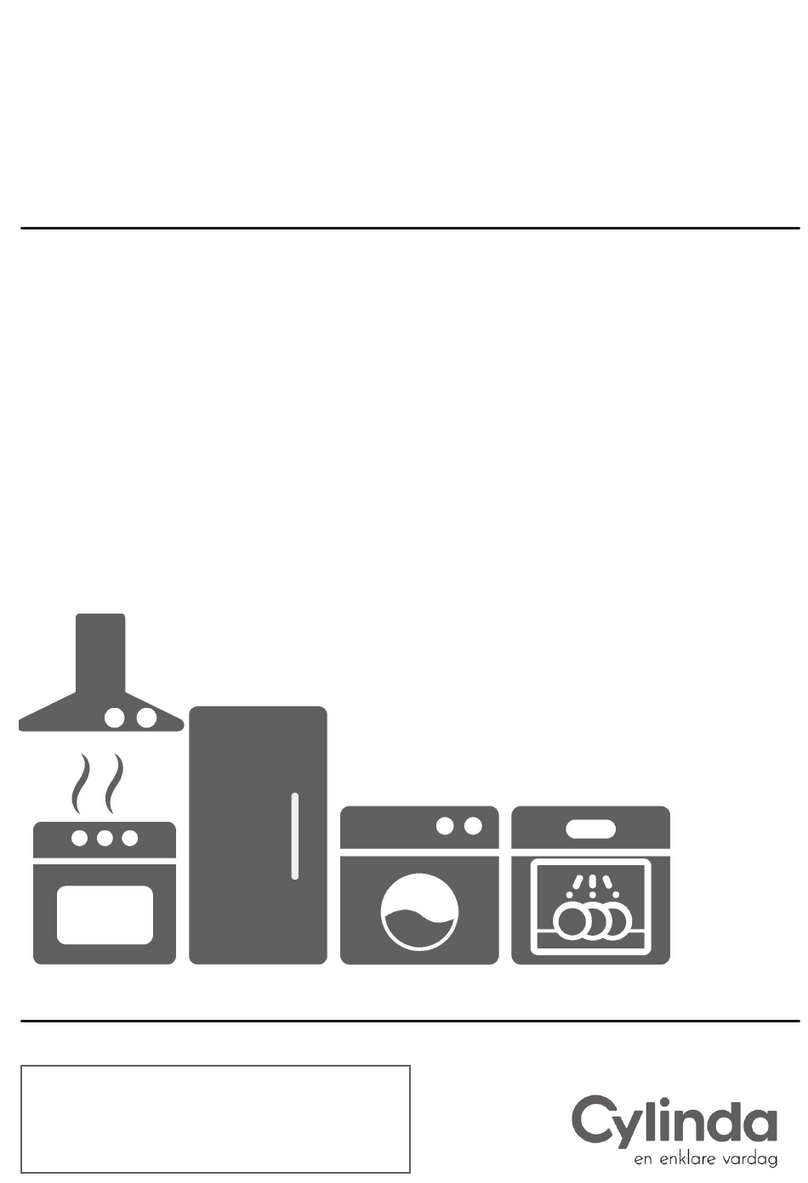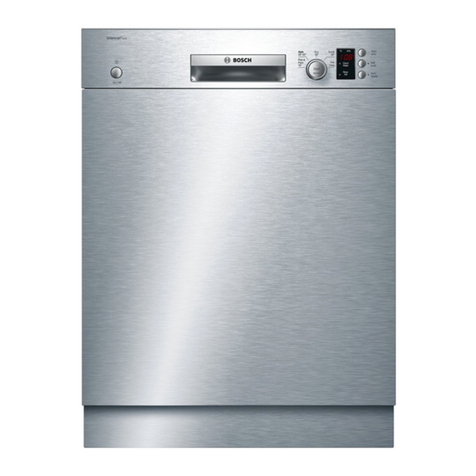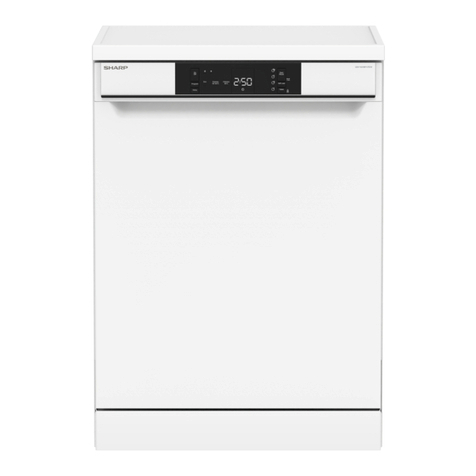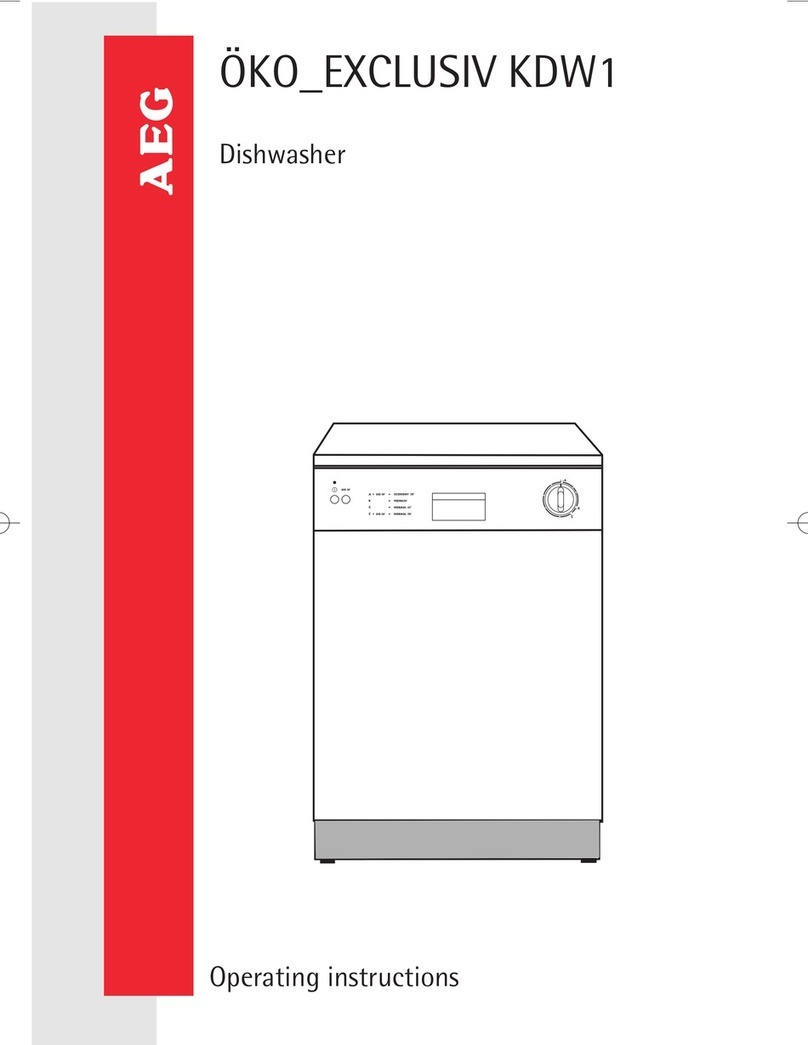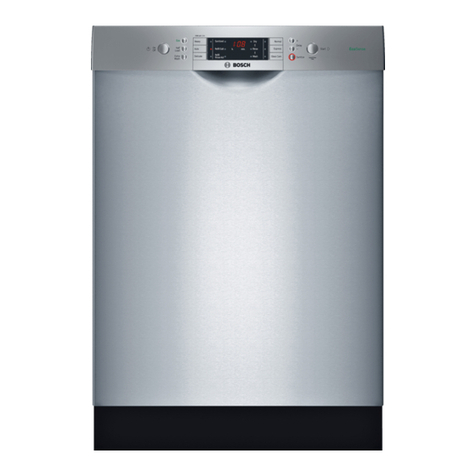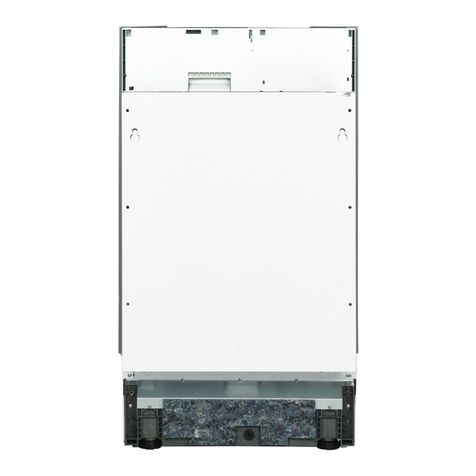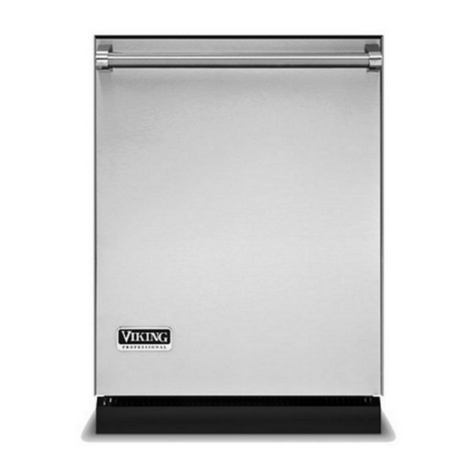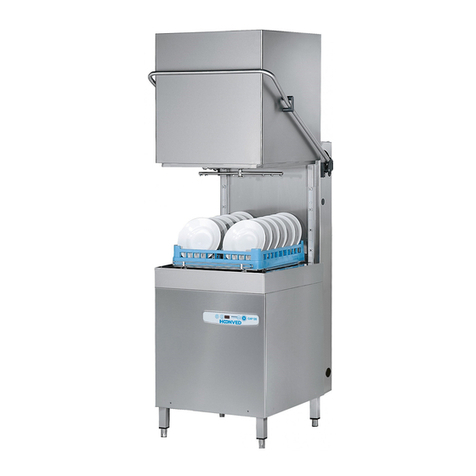Tisira TDW14I User manual

pg 1
tisira | www.tisira.com
USER MANUAL
14 PLACE INTEGRATED DISHWASHER
TDW14I
IMPORTANT // Please ensure that you read through this user manual prior to installation and use. This
manual contains important information to ensure optimal performance and keep you safe. Please retain your
proof of purchase, as this will be required in the event that you require warranty service. Remember to retain
this manual for future reference.
www.tisira.com

pg 2
www.tisira.com | tisira
CONGRATULATIONS ON THE SELECTION OF THIS TISIRA APPLIANCE. TISIRA
APPLIANCES HAVE BEEN SPECIFICALLY DESIGNED FOR AUSTRALIAN AND
NEW ZEALAND KITCHENS.
Please read through this user manual carefully as it contains information that
will ensure that your appliance is installed correctly, important operating &
care instructions and also some advice of what you need to do if this appliance
is not performing as intended.
HELLO

pg 3
tisira | www.tisira.com
CONTENTS
HELLO 2
CONTENTS 3
WARNINGS 4
PRODUCT OVERVIEW 5-6
OPERATING INSTRUCTIONS 7-17
MAINTENANCE 18-19
INSTALLATION 20-23
TROUBLESHOOTING 24-25
PRODUCT SPECIFICATIONS 26
NOTES 27
CONTACT DETAILS 28

pg 4
www.tisira.com | tisira
IMPORTANT // To get the best performance from your dishwasher, read all operating
instructions before using it for the first time.
SAFETY INFORMATION
WARNING // HYDROGEN GAS IS EXPLOSIVE
Under certain conditions, Hydrogen gas
may be produced in a hot water system that
has not been used for two weeks or more. If
the hot water system has not been used for
such a period, before using the dishwasher
turn on all hot water faucets and let the
water flow from each for several minutes.
This will release any accumulated hydrogen
gas. As the gas is flammable, do not smoke
or use an open flame during this time.
•Do not touch the heating element during
or immediately after use.
•Do not operate your dishwasher unless
all enclosure panels are properly in
place. Open the door very carefully if the
dishwasher is operating. There is a risk
of water leaking out.
•Do not place any heavy objects or
stand on the door when it is open. The
appliance could tip forward.
•Use only detergent and rinse additives
designed for an automatic dishwasher.
Never use soap, laundry detergent,
or hand washing detergent in your
dishwasher.
•Young children should be supervised
to ensure that they do not play with the
appliance.
•The door should not be left in the open
position since this could present a
tripping hazard.
•This appliance is not intended for use
by persons (including children) with
reduced physical, sensory or mental
capabilities, or lack of experience and
knowledge, unless they have been given
supervision or instruction concerning
use of the appliance by a person
responsible for their safety.
•If the supply cord is damaged, it must
be replaced by the manufacturer or its
service agent or a similarly qualified
person in order to avoid a hazard.
•Please dispose of packing materials
properly.
•This appliance is intended to be used in
household and similar applications such
as: staff kitchen areas in shops, offices
and other working environments;farm
houses: by clients in hotels, motels and
other residential type environments;
bed and breakfast type environments.
•Dishwasher detergents are strongly
alkaline. They can be extremely
dangerous if swallowed. Avoid contact
with the skin and eyes, and keep children
away from the dishwasher when the
door is open. Check that the detergent
receptacle is empty after completion of
the wash cycle.
WARNINGS

pg 5
tisira | www.tisira.com
PRODUCT
OVERVIEW
CONTROL PANEL
1. Program indicator light:When you
select a washing programme, the
corresponding light willdisplay.
2. Program select button: Press the
button to select the washing program.
3. Rinse aid indicator light:This light will
come on when the dispenser needs to
be refilled.
4. Drying light:To come on when the
dishwasher is drying.
5. Display:To display delay time or error
codes or the estimated time left for
programme to run.
6. Delay time: This option will allow you
to delay the start time of any wash
cycle for up to 24 hours (depending
on model). Select the delay start time
you want by pressing the DELAY pad.
Multiple pressing will increase the
delay hours.
7. ON/OFF Button: To turn on/off the
power supply.
8. Check water supply indicator: The
indicator lights up if the tap turn off or
the water supply interrupted or supply
hose kinked.
9. Child lock:The “child lock”will be
available when you press the button 3
seconds ,and the indicator lights upa
fter 6 times
10. 60 min programme: Daily wash in only
1 hour.
11. 3 in 1 function: The product is
offered with additional functions, The
additional function could be used with
the programme such as “intensive”
“Heavy” and “normal”.
12. After selecting the desired program,
close the door, the dishwasher in
function status.
1 235 6 789 10 11
Intensive
Hea v y
Rinse
Rapid
S o ak
Normal
4

pg 6
www.tisira.com | tisira
PRODUCT
OVERVIEW
DISHWASHER FEATURES
FRONT VIEW
1. Cutlery Tray
2. Upper Basket
3. Lower Basket
4. Detergent Dispenser
5. Cup Holder
6. Spray Arms
7. Filters
8. Rinse Aid Dispenser
1
2
3
4
6
7
5
8

pg 7
tisira | www.tisira.com
OPERATING
INSTRUCTIONS
ATTENTION // Before using your dishwasher for the first time, please make sure that you
read the following sections:
A. Fill the rinse aid dispenser B. Fill the detergent dispenser
A. FILL THE RINSE AID DISPENSER
FUNCTION OF RINSE AID
The rinse aid is automatically released during the last rinse in order to prevent water from
forming droplets on your dishes that can leave spots and streaks.
ATTENTION // Only use branded rinse aid in the dishwasher.
Never fill the rinse aid dispenser with any other substances (e.g. dishwasher cleaning agent,
liquid detergent). This would damage the appliance.
The rinse aid dispenser is located inside the door next to the detergent dispenser.
To fill the dispenser, open the cap and pour the rinse aid into the dispenser until the level
indicator turns completely black. The volume of the rinse aid container is about 140ml.
Be careful not to overfill the dispenser, because this could cause over sudsing. Wipe away any
spills with a damp cloth. Don’t forget to close the cap before you close the dishwasher door.
1. To open the dispenser, turn the cap to the “open” (left) arrow and lift it out.
2. Pour the rinse aid into the dispenser, be careful not to overfill.
3. Replace the cap by inserting it aligned with “open” arrow and turning it to the “closed”
(right) arrow.
ATTENTION // Clean up any rinse aid split during filling with an absorbent cloth to avoid
excess foaming during the next wash.
2
13

pg 8
www.tisira.com | tisira
OPERATING
INSTRUCTIONS
WHEN TO REFILL THE RINSE AID
DISPENSER
You can judge the amount of rinse-aid by
the colour of the optical level indicator “D”
located next to the cap. When the rinse-aid
container is full, the whole indicator will be
dark .As the rinse aid diminishes, the size of
the dark dot decreases.
IMPORTANT // You should never let the
rinse aid get below 1 / 4 full.
Full
3 / 4 full
1 / 2 full
1 / 4 full - Should refill to eliminate
spotting
Empty
ADJUSTING RINSE AID DISPENSER
The rinse aid dispenser has six settings.
Always start with the dispenser set on “4”
If spots and poor drying are problems,
increase the amount of rinse aid dispensed
by removing the dispenser lid and rotating
the dial to “5”. If the dishes still are not
drying properly or are spotted, adjust the
dial to the next higher number until your
dishes are spot-free. The dose is factory set
in position 5.
NOTE // Increase the dose if there are
drops of water or lime spots on the dishes
after washing. Reduce it if there are sticky
whitish streaks on the dishes or a bluish
film on glassware or knife blades.
FILL THE DETERGENT
DISPENSER
Detergents with its chemical ingredients
are necessary to remove dirt, crush dirt
and transport it out of the dishwasher.
Most of commercial quality detergents are
suitable for this purpose.
CONCENTRATED DETERGENT
Based on their chemical composition,
dishwasher can be split in two basic types:
•conventional, alkaline detergents with
caustic components
•low alkaline concentrated detergents with
natural enzymes
The use of “normal” washing programme
in conjunction with concentrated detergents
reduces pollution and is good for your dishes;
these washing programmes are specially
matched to the dirt dissolving properties of the
enzymes of the concentrated detergents. For
this reason ”normal” washing programme in
which concentrated detergents are used can
Adjust lever
(Rinse)
1
2
3
4
5
6
MA X
D (RINSE-AID
INDICATOR)
1
2
3
4
5
6
MA X

pg 9
tisira | www.tisira.com
OPERATING
INSTRUCTIONS
achieve the same results that can otherwise
only be achieved using ”intensive” programme.
DETERGENT TABLETS
Detergent tablets of different brands dissolve
at different speeds. For this reason some
detergent cannot dissolve and develop their
full cleaning power during short programmes.
Therefore please use long programmes
when using detergent tablets, to ensure the
complete removal of detergent residuals.
DETERGENT DISPENSER
The dispenser must be refilled before the
start of each washing cycle following the
instructions provided in the “Washing Cycle
Table”. Your dishwashers use less detergent
and rinse aid than conventional dishwashers.
Generally, only one tablespoon of detergent
is needed for a normal wash load. Also, more
heavily soiled items need more detergent.
Always add the detergent just before
starting the dishwasher, otherwise the tablet
can get damp and it will not dissolve properly.
1. If the lid is closed: press release button.
The lid springs open.
2. Always add the detergent just before
starting each washing cycle. Only use
branded detergent aid for dishwasher.
WARNING // Dishwasher detergent is
corrosive! Take care to keep it out of reach
of children. Use only detergent specifically
made for use in dishwashers. Keep your
detergent fresh and dry. o not put powder
detergent into the dispenser until you’re
ready to wash the dishes.
FILL IN THE DETERGENT
Fill the detergent dispenser with detergent.
The marking indicates the dosing levels , as
illustrated above:
1. Main washing cycle detergent dispenser.
MIN means approximately 20g of detergent.
2. Pre washing cycle detergent dispenser.
Approximately 5g of detergent.
Close the lid and press until it locks in place.
1
2
3
4
5
6
MA X
12
1
2

pg 10
www.tisira.com | tisira
OPERATING
INSTRUCTIONS
If the dishes are heavily soiled, place an
additional detergent dose in the pre-wash
detergent chamber. This detergent will
take effect during the pre-wash phase.
NOTICE // Information about the amount
of detergent to be used for each type of
programme can be found on the Washing
Cycle Table in the “Starting a washing
programme” section.
Please be aware that according to the level
of soiling and the specific hardness of water,
differences are possible. Please observe
the manufacturer’s recommendations on
the detergent packaging.
DETERGENTS
There are 3 sorts of detergents:
1. With phosphate and with chlorine
2. With phosphate and without chlorine
3. Without phosphate and without chloride
Normally, new pulverized detergents don’t
have phosphate. The water softener function
of phosphate is not given. In this case, we
recommend to fill the salt dispenser with
salt even when the hardness of the water is
only 6 dH. If detergents without phosphate
are used in cases where hard water is
supplied, often white spots appear on dishes
and glasses. In this case, please increase
the amount of detergent to achieve better
results.
Detergents without chlorine can only bleach
a little. Strong and coloured spots will not
be removed completely. In this case, please
choose a programme with higher temperature.
USE OF “3 IN 1” DETERGENT
TABLETS
GENERAL ADVICE
1. Before using these type of detergents,
you should first ready the manufacturer
instructions to check if their tablets are
compatible to the water hardness of
your water supply.
2. These products should be strictly
used according to the detergent
manufacturers instructions.
3. If you encounter problems when using “3
in 1” products for the first time then please
contact the detergent manufacturers care
line (the telephone number is given on the
product packaging). These products are
detergents with integrated and combined
detergent/rinse aid and salt functions.
SPECIAL ADVICE
When using combination products, the
rinse-aid and salt lights are no longer
useful. It may be helpful to select the lowest
possible setting for water hardness.
TO SELECT “3 IN 1” FUNCTION:
1. Close the door and select the 3 in 1
washing cycle by pressing the “3 in 1”
button until the “3 in 1” indicator blinks.
2. The 3 in 1 washing cycle will be available
after pressing the start/pause button , and
the”3 in 1” indicator lights.

pg 11
tisira | www.tisira.com
OPERATING
INSTRUCTIONS
TO CANCEL “3 IN 1” FUNCTION:
Follow the ‘Cancelling a programme in
progress’ instructions.
If you decide to switch to the use of a
standard detergent system we advise that
you:
1. Refill both the salt and rinse aid
compartments.
2. Switch the water hardness setting to
the highest possible position and run for
three normal cycles without load.
3. Readjust the water hardness settings
again according to the conditions for
your region
.
TURNING ON THE APPLIANCE
1. Close the door.
2. Make sure the spray arms are not
obstructed.
3. Switch the dishwasher on using the
“Power” button.
The additional indicators, delay start
indicators and status indicator could light
up periodically one bye one.
NOTE // A click could be heard when the
door is closed.
SELECT A PROGRAMME
Choose your programme according to the
type of load and how dirty it is.
The different programmes and their uses
are described in the “washing cycle table”
(see page 15). Use the programme selector
to select the expected programme.
CHANGE THE PROGRAMME.
A cycle that is underway can only be modified
if it has only been running for a short time.
Otherwise, the detergent may have already
been released, and the appliance may have
already drained the wash water. If this is
the case, the detergent dispenser must be
refilled (see the section entitled “Filling the
Detergent “).
Turn the appliance off and then turn it
on again by pressing the “Power” button.
Press the “Programme” button to choose
the expected cycle settings.
NOTE // If you open the door when the
washing cycle underway, the appliance will
pause and emit warning signals, the display
appears E1. When you close the door, the
machine will keep on working after 10
seconds.
The 6 programme lights show the state of
the dishwasher. If on of the programe lights
is on, the corresponding cycle is running. If
one of the programme lights is blinking, the
cycle is paused.
NOTE // If all the lights begin to glimmer,
that indicates the machine is out of order,
please turn off the main power and water
supply before calling a service.

pg 12
www.tisira.com | tisira
OPERATING
INSTRUCTIONS
FORGET TO ADD A DISH
A forgotten dish can be added any time before the detergent cup opens.
1. Open the door a little to stop the washing.
2. After the spray arms stop working, you can open the door completely.
3. Add forgotten dishes.
4. Close the door, the dishwasher will work after ten seconds.
WARNING // It is dangerous to open the door when washing, because the hot water may
scald you.
SWITCH OFF THE DISHWASHER
The digital display appears “---” and the buzzer rings 6 times, only in this case the programme
has ended. Turn off the dishwasher by pressing the Power button.
Open the door carefully. Hot steam may escape when the door is opened!
•Hot dishes are sensitive to knocks. The dishes should therefore be allowed to cool down
around 15 minutes before removing from the appliance.
•Open the dishwasher’s door, leave it ajar and wait a few minutes before removing the dishes.
In this way they will be cooler and the drying will be improved.
WHEN LOADING ITEMS TO BE WASHED:
•Locate sharp items so that they are not likely to damage the door seal.
•Knives and other utensils with sharp points must be loaded in the basket with their
•points down or placed in a horizontal position.
•When using your dishwasher, you should prevent plastic items from contacting with heating
element.
•Do not wash plastic items unless they are marked dishwasher safe or the equivalent. For
plastic items not so marked, check the manufacturer’s recommendations.

pg 13
tisira | www.tisira.com
OPERATING
INSTRUCTIONS
LOADING THE DISHWASHER
BASKETS
NOTE // Features and appearances of baskets
and cutlery tray may vary from your model.
ATTENTION // Before or after loading the
dishwasher baskets, scrape off any large
amounts of leftover food.
Place objects in the dishwasher in the
following way:
•Items such as cups, glasses, pots/pans,
etc. are placed upside down.
•Curve items, or those with recesses,
should be at a slant so that water can run
off.
•They are stacked securely and can not tip
over.
•They do not prevent the spray arms from
rotating while washing takes place.
•To avoid damage to glasses, ensure
they are not touching other items in the
dishwasher.
NOTE // Very small items should not be
washed in the dishwasher as they could
easily fall out of the baskets.
THE UPPER BASKET
The upper basket is designed to hold more
delicate and lighter dishware such as
glasses, coffee and tea cups, saucers, as
well as plates, small bowls and shallow
pans. Position the dishes and cookware so
that they do not get moved by the spray of
water.
Upp er B aske t
B1
B6
IN
C1
C14
B7
B12
A5
A2
A14
A10
UPPER BASKET
Type Item
A Cup
B Glass
C Saucer
ADjUSTING THE UPPER BASKET
The upper basket can be adjusted for
height by putting wheels of different height
into the rails. Long items, serving cutlery,
salad servers or knives should be placed
on the shelf so that they do not obstruct
the rotation of the spray arms. The shelf
can be folded back or removed when not be
required for use.
4

pg 14
www.tisira.com | tisira
OPERATING
INSTRUCTIONS
LOADING THE LOWER BASKET
We recommend that you place large items
which are most difficult to clean in to the
lower basket: pots, pans, lids, serving dishes
and bowls, as shown in the figure below.
It is preferable to place serving dishes and
lids on the side of the baskets in order to
avoid blocking the rotation of the top spray
arm. Pots, serving bowls, etc. must always
be placed top down.
Deep pots should be slanted to allow water
to flow out.
The bottom basket features fold down tine
rows so that larger or more pots and pans
can be loaded.
FOLDING RACKS
Folding racks consist of two parts and are
located on the lower basket of the machine.
Using the folding racks allows for more
room on the lower basket for larger items.
To use the folding racks, lift them up then
fold down as shown.
CUTLERY TRAY
Arrange the cutlery in the tray as shown.
LOWER BASKET
Type Item
G Soup Plate
H Dinner Plate
I Dessert Plate
CUTLERY TRAY
Type Item
1 Teaspoons
2 Dessert Spoons
3 Soup Spoons
4 Forks
5 Knives
1
2
3
4
2
2
1
5
1

pg 15
tisira | www.tisira.com
OPERATING
INSTRUCTIONS
LOADING CUTLERY & DISHES
Before loading the dishes you should
remove large left-over food scraps and
soften remnants of burnt food in pans.
The following items are not suitable for
washing in the dishwasher:
•Cutlery with wooden or mother-of-pearl
handles
•Plastic items that are not heat resistant
•Older cutlery with glued parts that is not
temperature resistant
•Bonded cutlery items or dishes
•Pewter or copper items
•Lead crystal glass
•Steel items subject to rusting
•Wooden platters
•Items made from synthetic fibre
•Take caution when loading dishwasher
as:
•Some types of glasses can become dull
after a large number of washes
•Silver and aluminium parts have a
tendency to discolour during washing
•Glazed patterns may fade if machine
washed frequently
NOTE // Do not load items that are dirty of
cigarette ash, candle wax, lacquer or paint.
When buying new dishes, ensure they are
suitable for dishwashers.
NOTE // Please do not overload your
dishwasher. There is only space for 14
standard dishes. This is important for
good results and for reasonable energy
consumption.
AT THE END OF THE WASH
When the working cycle has finished, the
buzzer of dishwasher will ring for 6 times,
then stop. Turn off the appliance using the
“Power” button and open the door of the
dishwasher. Wait a few minutes before
unloading the dishwasher to avoid handling
the dishes and utensils while they are still
hot and more susceptible to breakage. They
will also dry better.
REMOVING THE DISHES
To prevent water dripping from the upper
basket onto dishes on the lower basket,
empty the lower basket first and then the
upper basket.

pg 16 www.tisira.com | tisira
OPERATING
INSTRUCTIONS
WASHING CYCLE TABLE
Program Cycle Selection Information Description of
Cycle
Detergent
Pre/Main
Running
Time
(min)
Energy
(kWh)
Water
(L)
Intensive
For the heaviest soiled
loads, such as pots, pans,
casserole dishes and dishes
that have been sitting with
dried food on them for a
while.
Pre-wash(40ºC)
Main wash(55ºC)
Rinse 1
Rinse 2
Hot rinse(65ºC)
Drying
5/27.5g
(or 3 in 1) 150 1.35 20.0
Heavy
For heavy soiled loads, such
as pots, plates, glasses and
lightly soiled pans. Standard
daily cycle.
Main wash(60ºC)
Rinse 1
Rinse 2
Hot rinse(65ºC)
Drying
Rinse 1
Rinse 2
Hot rinse(50ºC)
Drying
5/27.5g
(or 3 in 1) 135 1.25 16.0
Normal
For normally soiled loads,
such as pots, plates, glasses
and lightly soiled pans.
standard daily cycle.
Main wash(45ºC)
Rinse
Hot rinse(50ºC)
Drying
5/27.5g
(or 3 in 1) 113 0.83 13.7
Rinse
For dishes that need to be
rinsed and dried only.
Pre-wash
Hot rinse(70ºC)
Drying
- 67 0.85 8.0
60 0.83 12.5
Rapid
A shorter wash for lightly
soiled loads that do not need
drying.
Main wash(40ºC)
Hot rinse(50ºC) 20g
5/20g
50 0.60 8.0
Soak
60min
To rinse dishes that you plan
to wash later on that day Pre-wash - 8 0.07 4.0
For lightly and normally
soiled plates and pans for
everyday

pg 17
tisira | www.tisira.com
MAINTENANCE
FILTERING SYSTEM
The filter is used to avoid the big remnants
and other sundries getting inside the
pump. Sometimes, an extra deposit of
residues can obstruct the water flow.
The filter system consists of a coarse
filter, a flat (Main filter) and a micro
filter (fine filter).
1. Flat filter - Food and debris will be
trapped by a jet on the lower spray arm.
2. Coarse filter - Big debris, such as bone
and glass that could clog the drain will
be trapped in the coarse filter.
3. To remove an item caught in this filter,
gently squeeze the tabs on the top of this
filter and lift it out.
4. Micro filter - This filter holds soil and
food residue in the sump area and
prevents it from being redeposit on the
dishes during a cycle.
•Inspect the filters for obstructions every
time the dishwasher has been used.
•By unscrewing the coarse filter, you
can remove the filter system. Remove
any food remnants and clean the filters
under running water.
STEP 1 // Rotate the coarse filter anti-
clockwise, filter, and then lift it up;
STEP 2 // lift the flat filter up
Repeat the steps in reverse to reinstall the
filtering system.
FILTER ASSEMBLY
The filter assembly should be cleaned once
a week with a brush. Then, reassemble the
filter parts as shown in the figures above and
reinsert the assembly in the dishwasher,
positioning in its seat and pressing downward.
Improper replacement of the filter may
reduce the performance level of the appliance
and damage dishes and utensils.
WARNING // Never run the dishwasher
without the filters in place.

pg 18
www.tisira.com | tisira
MAINTENANCE
CLEANING THE SPRAY ARMS
It is necessary to clean the spray arms
regularly to ensure efficient operation of
the spray arm jets and bearings.
To remove the spray arms, screw off the
nut clockwise to take out the washer on
top of the spray arm and remove the arm.
Wash the arms in warm soapy water and
use a soft brush to clean the jets. Rinse
thoroughly and replace.
CLEANING THE DISHWASHER
To clean the exterior and rubber parts
of the dishwasher, do not use solvents or
abrasive cleaning products. Use only a cloth
and warm soapy water. To remove spots or
stains from the surface of the interior, use
a cloth dampened with water and a little
white vinegar, or a cleaning product made
specifically for dishwashers.
AFTER EVERY WASH
After every wash, leave the door slightly
ajar so that moisture and odours are not
trapped inside.
REMOVE THE PLUG
Beforecleaningorperformingmaintenance,
always remove the plug from the socket.
WHEN YOU GO ON HOLIDAY
When you go on holiday, it is recommended
thatyourunawashcyclewiththedishwasher
empty and then remove the plug from the
socket, turn off the water supply and leave
the door of the appliance slightly ajar. This
will help the seals last longer and prevent
odours from forming in the appliance.
TO REMOVE SPOTS FROM
GLASSWARE
1. Take out all metal utensils out of the
dishwasher.
2. Do not add detergent.
3. Choose the longest cycle.
4. Start the dishwasher and allow it to run
for about 18 to 22 minutes, then it will be
in the main wash.
5. Open the door to pour 2 cups of white
vinegar into the bottom of the dishwasher.
6. Close the door and let the dishwasher
complete the cycle. If the vinegar does not
work: Repeat as above, except use 1/4 cup (60
ml)of citric acid crystals instead of vinegar.
MOVING THE APPLIANCE
If the appliance must be moved, try to
keep it in the vertical position. If absolutely
necessary, it can be positioned on its back.
SEALS
One of the factors that cause odours to
form in the dishwasher is food that remains
trapped in the seals. Periodic cleaning with
a damp sponge will prevent this.

pg 19
tisira | www.tisira.com
INSTALLATION
WARNING // Disconnect electrical power
before installing dishwasher. Failure to do so
can result in death or electrical shock.
POSITIONING AND LEVELLING
1. Remove the appliance from all packaging
and check that it has not been damaged
during transportation. If it has been
damaged, contact the retailer and do not
proceed any further with the installation
process.
2. Check the dishwasher by placing it so that
its sides or back panel are in contact with
the adjacent cabinets or even with the
wall. This appliance can also be recessed
under a single work top
3. Position the dishwasher on a level
and sturdy floor. If the floor is uneven,
the front feet of the appliance may be
adjusted until it reaches a horizontal
position. If the appliance is levelled
correctly, it will be more stable and much
less likely to move or cause vibrations
and noise while it is in operation.
NOTICE // The maximum adjustment height
of the feet is 20 mm.
Make sure that the carpet does not obstruct
the openings at the bottom base.
CONNECTING THE WATER AND
ELECTRIC SUPPLIES
ATTENTION // Connection to the water
and electrical supplies should only be
performed by a qualified technician.
The dishwasher should not stand on top of
the water hoses or the electric supply cable
The appliance must be connected to the
water supply network using new piping. Do
not use old piping.
CONNECTING THE WATER INLET
HOSE
Connect the cold water supply hose to a
threaded 3/4 inch connector and make sure
that it is fastened tightly in place.
If the water pipes are new or have not
been used for an extended period of time,
let the water run to make sure that the
water is clear and free of impurities. If this
precaution is not taken, there is a risk that
the water inlet can get blocked and the
appliance could be damaged.
CONNECTING THE WATER OUTLET
HOSE
Put the hose into a drainage hose with
diameter greater than 40mm or into a sink,
in both cases, make sure that the outlet pipe
is straight and not higher than 1m from the
floor.
If the length of the hose is not sufficient,
order it from an authorised service agent
so that the extension made from the same
material as the original. Remember that
the length of the hose should not exceed 4
meters even when with an extension.
If the drainage hose is longer than 4 meters
the dishes will not be cleaned.
Properly secure your hose firmly to the
drainage pipe to avoid it coming off during
the washing process.

pg 20
www.tisira.com | tisira
INSTALLATION
ELECTRICAL CONNECTION
NOTICE // During installation, the power
supply must not be excessively or dangerously
bent or flattened.
Before inserting the plug into the electrical
socket, make sure that:
•the socket is earthed and complies with
current regulations;
•the socket can withstand the maximum
load of the appliance, which is indicated
on the data plate located on the inside of
the door(see description of the appliance);
•the power supply voltage falls within the
values indicated on the data plate on the
inside of the door;
•the socket is compatible with the plug of
the appliance. If this is not the case, ask an
authorised technician to replace the plug
(seek assistance); do not use extension
cables or multiple sockets.
•Once the appliance has been installed,
the power supply cable and the electrical
socket should be easily accessible.
•Thecableshouldnotbebentorcompressed.
•If the power supply cable is damaged, it
must be replaced by the manufacturer or
its Technical Assistance Service in order
to prevent all potential hazards.
•The company shall not be held responsible
for any incidents that occur if these
regulations are not observed.
HOW TO DRAIN EXCESS WATER
FROM HOSES
If the sink is 1000mm higher from the floor,
the excess water in hoses cannot be drained
directly into the sink. It will be necessary to
drain excess water from hoses into a bowl
or a suitable container that is held outside
and lower than the sink.
SYPHON CONNECTION
The waste connection must be at a height
of between 50cm (minimum) and 100cm
(maximum) from the bottom of the dish. The
water drain hose should be fixed by a hose clip.
STARTING YOUR DISHWASHER
The followings should be checked before
starting the dishwasher:
1. Whether the dishwasher is level and fixed
2. Whether the inlet valve is opened
3. Whether there is leakage at the
connections of the conducts
4. Whether the wires are tightly connected
5. Whether the power is switched on
6. Whether the inlet and drain hoses are knotted
7. All packing materials and printings
should be taken out from the dishwasher
NOTICE // After installation, please put this
manual into the bags of printings. The content
of this manual is very helpful to the users.
NOTICE // Other means for disconnection
from the supply must be incorporated in
the fixed wiring with at least 3mm contact
separation in all poles.
max1100mm
min 500mm
min120mm
min 40mm
Table of contents
Other Tisira Dishwasher manuals
